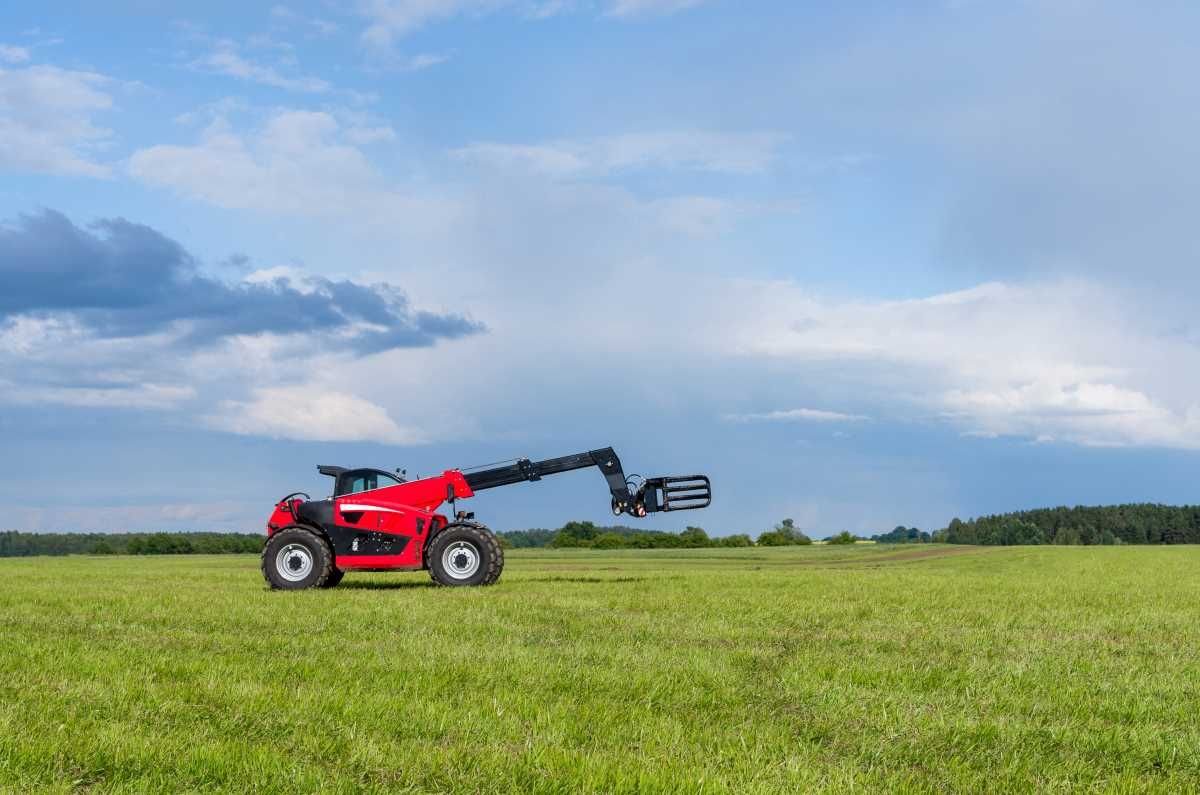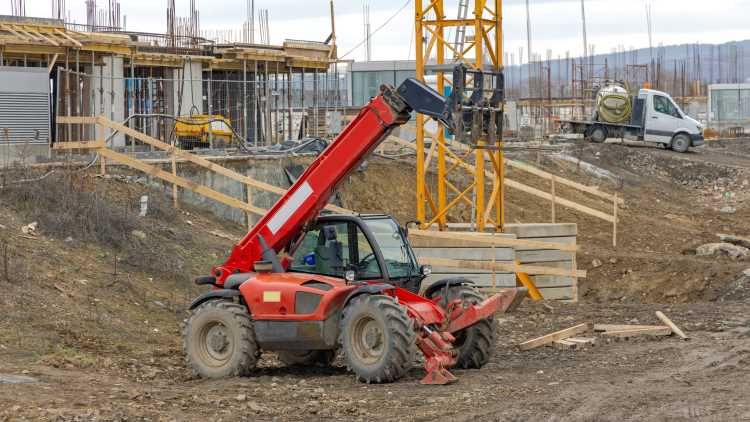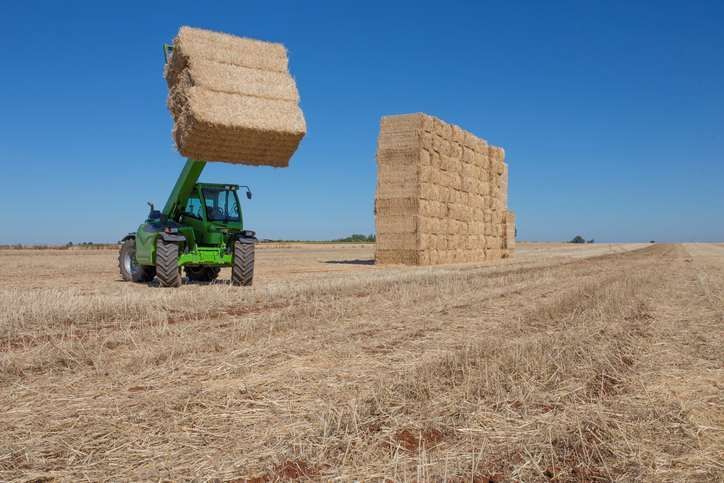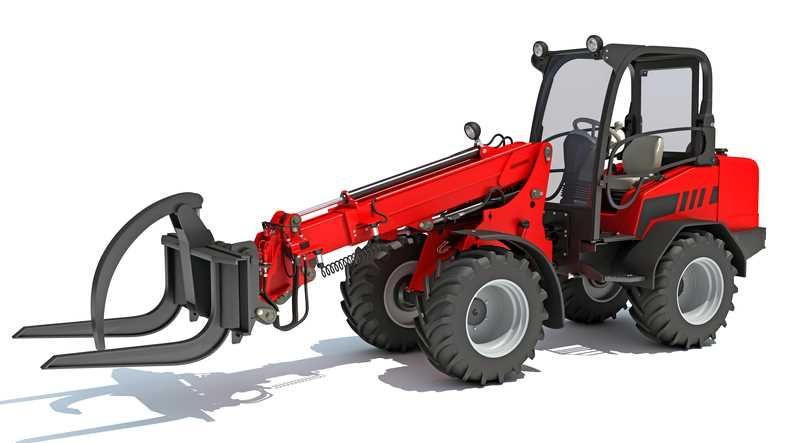(click for direction)
Emergency Number: 0409 900 902
What is a telehandler?
What a telehandler or telescopic handler is, what types of telehandlers exists and applications.

The Basics of Telehandlers
What is a Telehandler?
A telehandler, at its core, is a type of material handling equipment that combines the functions of a forklift and a crane. It's designed to lift, move, and place heavy loads with precision and control. The key feature that sets telehandlers apart from other equipment is their telescopic boom, which can extend and retract as needed.
How Does a Telehandler Work?
A telehandler operates by utilising a telescopic boom attached to a sturdy chassis. This telescopic boom extends and retracts, thanks to hydraulic systems, allowing the machine to reach different heights and distances. At the end of the boom, various attachments like forks, buckets, or hooks can be mounted to lift and handle different types of loads. The operator, seated in the cab, controls the telehandler's movements, steering, and the functions of the hydraulic system. Four-wheel steering enhances maneuverability, making it suitable for navigating confined spaces. Telehandlers come in various sizes with different load capacities, and adherence to safety guidelines and load charts is crucial for their safe and efficient operation.
Types of Telehandlers

Fixed-Frame Telehandlers
A fixed-frame telehandler, also known as a rigid-frame telehandler or non-rotating telehandler, is a type of heavy machinery used for lifting, moving, and placing loads in various industries, including construction, agriculture, and industrial settings. Unlike rotating telehandlers, which have the capability to rotate their entire upper structure 360 degrees, fixed-frame telehandlers have a stationary chassis. This means that the chassis does not rotate independently from the telescopic boom.
One of the distinguishing features of fixed-frame telehandlers is their limited rotation. While they can steer their wheels for navigation and maneuvering, the entire chassis remains fixed in place. This limitation means that they cannot rotate the entire machine to position a load precisely like rotating telehandlers can. However, this does not diminish their usefulness in a wide range of lifting and material handling tasks.
Fixed-frame telehandlers are valued for their versatility. They are well-suited for tasks that involve lifting heavy loads to significant heights. Their design typically prioritises stability and sturdiness, allowing them to handle demanding applications with ease. These telehandlers are often chosen for tasks such as lifting construction materials, stacking pallets, handling agricultural products, and more.
Another advantage of fixed-frame telehandlers is their cost-effectiveness. They tend to be more budget-friendly than rotating telehandlers, making them a preferred choice for operators and businesses looking for a reliable and economical lifting solution. The cost savings can be especially significant when the specific task at hand does not require the advanced rotation capabilities of a rotating telehandler.
Rotating Telehandlers
Rotating telehandlers, often referred to as telehandlers with a rotating turret or turntable, are a specialised type of telehandler designed for lifting and material handling tasks that require precise rotation of the load. Unlike fixed-frame telehandlers, which have a stationary chassis, rotating telehandlers have a turret or turntable at the top of the chassis that can rotate a full 360 degrees independently from the chassis itself.
One of the primary features that sets rotating telehandlers apart is their ability to rotate the entire upper structure of the machine. This allows the operator to position the load with exceptional precision, making them particularly useful for tasks where precise load placement is essential. The rotating turret provides a high degree of flexibility, making it easier to handle materials in tight or confined spaces and to reach around obstacles.
Rotating telehandlers are commonly used in various industries and applications. In construction, they excel at tasks such as steel erection, placing building materials with precision, and working in congested construction sites where space is limited. In agriculture, they can be used for tasks like stacking bales of hay or straw and loading materials onto trucks or trailers. Their versatility extends to industrial settings, where they are used for moving heavy equipment or handling materials in warehouses and manufacturing facilities.
The operator's cab in a rotating telehandler is typically positioned on the turret, allowing the operator to have a clear view of the load and the surroundings, which is crucial for safe and efficient operation. The telescopic boom, similar to that of fixed-frame telehandlers, can extend and retract, providing reach and lift capacity as needed.
Key Components of a Telehandler
Telehandlers consist of several essential components, including:
Boom
The boom is the telescopic arm of the telehandler. It can extend and retract to reach various heights and distances.
Fork Attachment
Fork attachments are commonly used with telehandlers for lifting and carrying loads, similar to forklifts.
Hydraulic System
The hydraulic system powers the boom and attachments, providing the necessary force and control.
Chassis
The chassis is the machine's frame, supporting all other components and providing stability.
Benefits of Using Telehandlers
Versatility
Telehandlers are versatile machines that can perform a wide range of tasks, from lifting materials on construction sites to handling hay bales on farms.
Reach and Height
One of the primary advantages of telehandlers is their ability to reach high places and extend horizontally, making them invaluable in tasks that require elevation and distance.
Load Capacity
Telehandlers are known for their impressive load-carrying capacity, making them suitable for heavy lifting.
Manoeuvrability
Despite their size and power, telehandlers are surprisingly agile and can operate in confined spaces.
Applications of Telehandlers
Construction Sites
Telehandlers are commonly used in construction for tasks such as lifting and placing steel beams, transporting construction materials, and working at heights.
Agriculture
In agriculture, telehandlers are used for tasks like loading and unloading grain, stacking hay bales, and lifting heavy farm equipment.

Warehousing
Warehouses utilise telehandlers for efficient pallet stacking, material handling, and storage optimisation.
Landscaping
Landscaping professionals use telehandlers for tasks like tree planting, moving large rocks, and installing irrigation systems.
Telehandlers and Safety
Telehandler operators need to undergo thorough training to ensure they can handle the equipment safely and efficiently. This training is essential not only for the operator's safety but also for the safety of everyone on the worksite.
In addition to training, regular inspections and maintenance of the telehandler are critical. These checks are necessary to keep the machine in optimal condition, preventing any potential malfunctions that could lead to accidents. Routine maintenance also extends the lifespan of the equipment, ensuring it remains reliable over time.
When lifting and moving materials, it's important to secure and balance the load correctly. This helps prevent accidents and injuries, ensuring that the telehandler operates smoothly and safely throughout its tasks.
Telehandler vs. Forklift: The Difference?

Telehandlers and forklifts are distinct material-handling machines used across different industries, each with its own design, capabilities, and applications. Forklifts are characterised by their compact and low-profile design, typically featuring dual front wheels and a front-mounted mast that supports two forks for lifting and carrying loads. They excel at vertical lifting tasks, operating within a limited vertical range. Forklifts come in various sizes and load capacities, with smaller models suitable for lighter loads and larger ones capable of handling heavier materials. They are commonly found in warehouses, manufacturing facilities, and indoor environments where precise vertical lifting and load placement are essential.
In contrast, telehandlers have a more versatile and robust design. They feature a larger chassis with four-wheel steering, making them highly maneuverable. The most distinctive feature of telehandlers is their telescopic boom mounted on the front. This telescopic boom can extend and retract, providing both vertical and horizontal reach. Telehandlers are known for their higher lift capacities, making them suitable for lifting heavier loads compared to similarly sized forklifts. Their ability to reach high and far makes them ideal for a wide range of outdoor and off-road applications, including construction, agriculture, landscaping, and more. Telehandlers are often chosen for tasks that require not only vertical lifting but also the ability to handle materials at different angles and reach over obstacles.
Furthermore, forklifts typically employ rear-wheel steering, allowing them to navigate in tight spaces with a small turning radius. In contrast, telehandlers often feature four-wheel steering, providing excellent maneuverability and the ability to navigate efficiently in confined areas and on rough terrain. When choosing between a telehandler and a forklift, the decision hinges on the specific requirements of the task and the operating environment. Forklifts are the go-to choice for indoor settings where vertical lifting and precise load placement are paramount, while telehandlers shine in outdoor and off-road scenarios that demand both horizontal and vertical reach and versatility.
Choosing the Right Telehandler
Understanding Your Needs
Choosing the right telehandler begins by understanding your specific needs. Assess your application, load capacity, reach requirements, and the terrain you'll be working on. Consider attachment needs, maneuverability in your work environment, operator comfort and visibility, maintenance, safety features, and budget constraints. This initial understanding ensures that the selected telehandler aligns with your project requirements, promotes safety, and maximises efficiency, ultimately leading to a successful and productive equipment choice.
Budget Considerations
Budget considerations play a significant role when choosing the right telehandler. While it's essential to find a telehandler that meets your operational needs, it's equally crucial to stay within your budget. Consider not only the initial purchase price but also factor in long-term costs like maintenance, fuel, and potential resale value. Striking the right balance between functionality and affordability ensures that your telehandler investment remains cost-effective throughout its lifecycle, allowing you to achieve your project goals without breaking the bank.
Rental vs. Purchase
Choosing between renting and purchasing a telehandler depends on your project's specific needs and duration. If you have short-term or occasional requirements, renting may be cost-effective, offering flexibility and access to different telehandler models. On the other hand, if you anticipate long-term or frequent usage, purchasing can be a better investment, providing you with a dedicated machine that can be tailored to your precise requirements. Evaluate your project's timeline, budget, and ongoing needs to determine whether renting or buying a telehandler makes the most sense for your situation. Heavy Lift Forklifts have a range of forklifts for rent, so if you want to hire telehandler in Melbourne and Victoria, come to see us or call us on (03) 9762 4965
Maintenance and Care
Proper maintenance and care of a telehandler are essential to ensure its safe and efficient operation, prolong its lifespan and minimise downtime. Here are key maintenance practices and care tips for a telehandler:
Regular Inspections
Conduct routine visual inspections before each use to check for any visible damage, loose parts, or leaks. Look for signs of wear and tear on tires, hydraulic hoses, and attachments.
Lubrication and Fluid Checks
Ensure that all moving parts are adequately lubricated according to the manufacturer's guidelines. Regularly grease pivot points, pins, and other components that require lubrication to prevent excessive wear.
Repairs and Upkeep
When significant maintenance or repairs are required, rely on qualified technicians or service personnel who are experienced with telehandlers. Attempting complex repairs without proper expertise can lead to further damage. Replace worn or damaged parts promptly to prevent further deterioration. It's essential to use genuine replacement parts recommended by the manufacturer to maintain optimal performance and safety. Timely repairs and upkeep are crucial to keep your telehandler in optimal working condition.
Considering the Environment
Emissions
Telehandler emissions, primarily stemming from diesel-powered engines, pose environmental challenges due to the release of carbon dioxide (CO2), nitrogen oxides (NOx), and particulate matter (PM). CO2 contributes to global warming, while NOx and PM can lead to air pollution and respiratory issues. Several strategies can be employed to mitigate these emissions. These include adopting cleaner engine technologies, exploring alternative fuels like biodiesel and natural gas, using exhaust after-treatment systems, conducting regular maintenance, and providing operator training for more efficient telehandler operation. Emphasising environmental responsibility by implementing these measures can help reduce the environmental impact of telehandler emissions and contribute to a more sustainable approach in various industries.
Fuel Efficiency
Fuel efficiency is a crucial aspect of environmental considerations for telehandlers, which often rely on diesel-powered engines. These machines consume significant amounts of fuel, impacting both costs and the environment. Improving fuel efficiency is essential, and strategies include adopting modern engine technology, proper load management, regular maintenance, idle reduction, and eco-driving practices. Exploring alternative fuels like biodiesel or natural gas can further reduce the carbon footprint of telehandlers. Promoting these practices not only leads to cost savings but also contributes to a cleaner and more environmentally responsible approach in various industries where telehandlers are vital equipment.
Telehandlers in the Future
As technology advances, telehandlers will likely see improvements in efficiency, safety features, and environmental sustainability.
Conclusion
Telehandlers are remarkable machines that have revolutionised material handling across various industries. Their versatility, reach, and load-carrying capacity make them indispensable assets in construction, agriculture, warehousing, and landscaping. By understanding their capabilities and safety requirements, you can harness the full potential of telehandlers for your specific needs.
Telehandler - FAQs
-
What industries commonly use telehandlers?
Telehandlers are commonly used in construction, agriculture, warehousing, and landscaping industries, among others.
In the construction sector, they are instrumental in lifting and positioning heavy materials like steel beams and concrete blocks, thanks to their impressive reach and maneuverability.
In agriculture, telehandlers handle tasks such as loading and stacking hay bales and moving heavy farming equipment, adapting to the ever-changing demands of farming operations. Warehouses rely on telehandlers for efficient pallet stacking, material handling, and maximising storage space by reaching high shelves and navigating narrow aisles.
Landscaping professionals utilise telehandlers in outdoor environments for planting trees, moving large rocks, and installing irrigation systems. These machines handle various material transport tasks in manufacturing facilities, including moving raw materials and positioning machinery. Additionally, telehandlers have a role to play in utilities for pole setting, equipment maintenance, and line installation, thanks to their exceptional reach and height capabilities. They are also essential in the oil and gas industry, aiding drilling and exploration operations and handling heavy equipment on oil rigs.
Moreover, telehandlers are deployed in mining operations for material handling in rugged terrains, and waste management facilities benefit from their efficient waste material movement and stacking capabilities.
Furthermore, the military utilises telehandlers for material handling and logistics support in various operations.
Telehandlers continue to find applications in new industries, underlining their adaptability and value across diverse professional settings.
-
Are telehandlers easy to operate?
Telehandlers are generally designed to be user-friendly, but their ease of operation depends on operator training, experience, and the specific conditions in which they are used. Proper training covers machine controls, stability, load capacity, and safety procedures. Intuitive control systems and safety features enhance usability, but operators must also be skilled at maneuvering in various environments and maintaining stability. Experience plays a role in efficiency, and adverse conditions may require additional training and expertise for safe operation. Overall, telehandlers can easily operate with the right training and experience.
-
Can telehandlers be used indoors?
Telehandlers can be used indoors, but their indoor suitability depends on factors like size, tire type, emissions, height restrictions, load capacity, and operator training. Compact telehandlers with non-marking or solid tires are preferred for indoor use. Low-emission or electric engines are ideal for maintaining indoor air quality. Operators must be trained for precise navigation in tight indoor spaces. Matching the telehandler's capabilities to the indoor environment's specific requirements is essential.
-
How often should I service my telehandler?
Regular service and maintenance should follow the manufacturer's recommendations and usage frequency.
Need HEAVY EQUIPMENT MElboUrne and VIC?
Forklift rental is cost-effective, and you can consider hiring to meet any seasonal peaks.
Quick Links
Contact info
Address:
826 Mountain Hwy, Bayswater VIC
Emergency Number:
0409 900 902
Phone:
(03) 9762 4965
Follow Us On:
Business Hours
- Mon - Thu
- -
- Friday
- -
- Sat - Sun
- Appointment Only
24-hour emergency
Public holidays: Closed
ABN: 55179159792
Payment Options




